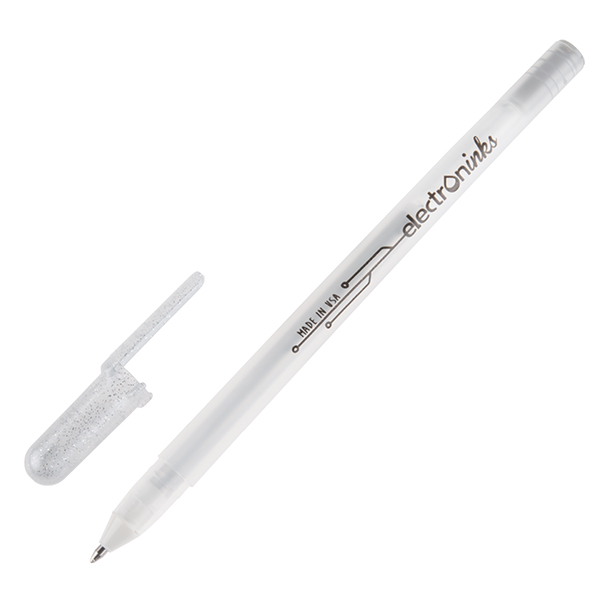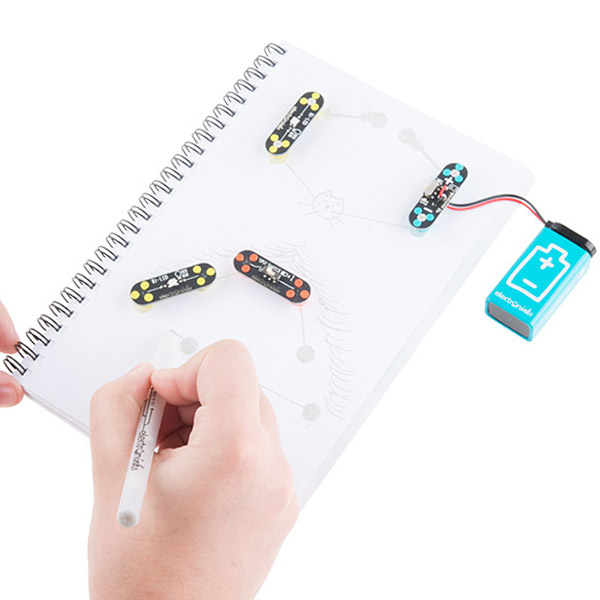This is the Circuit Scribe Conductive Ink Pen, a simple looking ball-point pen that allows you to draw circuits instead of soldering or wiring them to a breadboard. This is the same pen found in the Circuit Scribe Lite Kit just without the LED module and batteries, we understand that you may just need to draw out a quick circuit with your own parts or need a replacement pen.
With Circuit Scribe you can draw exactly what you want, no wires or breadboard required. You can build a circuit with nothing but a coin battery, paper clip, and LED, or build out complex circuits with multiple components. The Conductive Ink Pen uses a non toxic, silver conductive ink that writes on any surface a regular roller ball pen would with a resistance of 2-10 Ohms/cm.
- Ink Resistance: 2-10 Ohms/cm
- Line Width: 0.4mm
- Squeeze-Free Pen
Circuit Scribe Conductive Ink Pen Product Help and Resources
Origami Paper Circuits
May 26, 2015
A quick tutorial to get you started in the world of light up origami flowers.
The Great Big Guide to Paper Circuits
May 22, 2015
Let's take a look at different materials we can use to combine paper crafting and electronics.
**Dry time comparison.**
For a good look at dry times between several condictive inks, take a look here: http://youtu.be/wqvFT4qTNm8?t=54s.
Comments
Looking for answers to technical questions?
We welcome your comments and suggestions below. However, if you are looking for solutions to technical questions please see our Technical Assistance page.
Customer Reviews
No reviews yet.



So if you go over the line multi times (vertically stacked, or horizontally thick) does it reduce the resistance?
I also tried it, by allowing ink to dry and stacking the coats of ink - a short run of 8 ohms became 4 ohms when doubled up, so yes here as well.
Just gave it a try. 30mm long x 1.5mm wide - 160Ω, 30mm long x 3mm wide - 36Ω
Has me wondering if I could make an adapter for my old HP 7450 plotter to hold the pen and draw detailed circuit boards on plain phenolic boards. Hhhhhmmmm....
Got one of these from the Kickstarter.
They work really well and the ink is really durable. My 4yo daughter can use it with little help and has learned a lot about electricity (and power outage!) thanks to this neat product. The ink does not smear and dries almost instantly; it's like using a croyola felt pen.
Strange question, but has anyone tried soldering to it? I'm using this for a project and I would like to be able to solder directly to it.
Great product, especially since it drys extremely fast compared to other pens.
I was wondering if this could be used to short out a portion of the resistance track in a potentiometer? For example, guitar volume pedal pots only move about 1/4 turn. They can rotate over the full range, but when installed in the volume pedal, the linkage only moves it about 90 degrees. So they make these special pots, which are expensive and hard to find and take a long time to get. The resistance track is only over that 1/4 turn, and then the rest of the way around is close to a short. Obviously you have to pry the back cover off to see all this. So I'm wondering if I good use this pen on say a 1Meg linear pot, and draw over 3/4 of the turn (OK a little less, since it's not 360 degrees), and end up with one of these special pots?
Hope this makes sense, thanks in advance for your thoughts
Has anyone tried washing it? I was thinking of using it on a soft circuit instead of conductive thread, but I was wondering how it holds up in the wash.